Research on optimisation of electronic information engineering course structure and modular design based on graph neural network
Published Online: Mar 17, 2025
Received: Oct 02, 2024
Accepted: Jan 29, 2025
DOI: https://doi.org/10.2478/amns-2025-0162
Keywords
© 2025 Xinli Ma, published by Sciendo
This work is licensed under the Creative Commons Attribution 4.0 International License.
Electronic information engineering is a comprehensive discipline involving electronic technology, information technology and communication technology. With the development of science and technology, electronic information engineering is more and more widely used in various fields and has become the pillar industry of modern society, which plays an important role in social development and scientific and technological progress [1-2]. Therefore, the structural optimization and modular design of electronic information engineering courses must be in line with the direction of modern industrial demand and scientific and technological development. Through the reasonable optimization design of electronic information engineering courses, students can be trained to have a solid theoretical foundation and practical ability so that they can adapt to the development needs of the electronic information engineering field [3-6]. At the same time, by cultivating students’ innovative consciousness and teamwork ability, they can become electronic information engineering professionals with international vision [7-8].
Optimizing the course structure is an effective way to improve students’ learning effect and interest. Students’ needs can be better met through the introduction of interdisciplinary learning, personalized curriculum, innovative courses, and the integration of practical teaching [9-11]. However, attention needs to be paid to teacher training and support of educational resources to address possible challenges. Schools should regularly evaluate the effectiveness and, based on the evaluation results, continuously improve and adjust the curriculum to meet future development trends [12-14]. With the development of society and the promotion of educational reform, the design and implementation of college curricula are also constantly innovating and improving. Modular curriculum design and implementation in college education is gradually receiving attention and emphasis. The modular design of the curriculum lies in the realization of personalized learning and diversified development so as to improve the quality of education [15-18].
Electronic information engineering is aimed at cultivating specialists with comprehensive quality and innovative consciousness in electronic information technology. It relies on the basis of electronic science and technology, communication engineering and other disciplines involving electronic technology, communication technology, computer technology and other fields, aiming to cultivate high-quality professionals who are able to adapt to the market demand and can innovate. Literature [19] outlines the positioning and talent training objectives of electronic information engineering majors in colleges and universities and puts forward reform measures from the mode of talent training, strengthening scientific research and other aspects to adapt to the needs of talent training in the new era, highlighting the strong professional characteristics. Literature [20] emphasizes that people do not pay enough attention to vocational education, which leads to the phenomenon of an imperfect vocational education personnel training system, thus introducing the electronic information engineering major “3 + 4” talent training mode, based on practical experience to discuss. Literature [21] is based on the current situation of teaching electronic information specialties and professional characteristics, according to the four-dimensional integration of the system framework to build a professional practice team, in order to improve the electronic information engineering specialties based on innovation and entrepreneurship talent training system. Literature [22] discusses the innovation and practice of talent cultivation mode of electronic information engineering under the background of industry-teaching integration, and under the guidance of implementing collaborative education, creates the industry and demand chain of this specialty through the construction of faculty, curriculum system design, etc., in order to realize the fusion of professional talent cultivation and technological innovation. Literature [23] analyzes the practical ability of college talents in the context of the transformation and development of colleges and universities, takes the electronic information engineering specialty as the research object, and puts forward the path of cultivating students’ practical ability.
With the development of society and the advancement of education reform, the design and implementation of college curricula are also constantly innovated and improved. The optimization of curriculum structure and modularization design is to better cultivate students’ comprehensive quality and improve their learning effect and adaptability. Literature [24] pointed out the deficiencies of the teaching system of electronic information engineering and put forward the design scheme of the teaching system from the aspects of comprehensive, integrated curriculum design and construction, which improves the practical ability and innovation consciousness of electronic information students by introducing the cultivation mode of applied practical ability into the teaching activities. Literature [25] examined the application of information technology in curriculum optimization. Combining the data from the course education decision-making system and students’ post-course responses, the analysis based on the fuzzy logic system pointed out that mobile learning technology provided better decision analysis for course optimization. Literature [26] emphasizes the importance of curriculum design. It compared the innovative design of courses in major universities, used interactivity as a reference standard for measuring course quality, and elaborated on the role of course quality evaluation in promoting course design, revealing that course design is an important strategy to ensure the training of professional talents. Literature [27] not only identified the category, of course, modularization through literature review but also launched interviews to illustrate this category and compiled these categories into multiple design principles based on the interview results and the ADDIE curriculum model, laying the foundation for modular course design.
In this paper, a recommendation algorithm for a set knowledge graph is constructed using a graph convolutional network combined with a knowledge graph model based on semantic matching. On this basis, this paper designs an electronic information engineering online learning platform incorporating the algorithm, aiming to make full use of the performance of the algorithm and achieve course structure optimization. In addition, a modular teaching mode for electronic information engineering based on the online learning platform is designed.It is also applied to colleges and universities to analyze the actual effects of graph neural networks in optimizing course structure and modular teaching of electronic information engineering.
One of the main advantages of Graph Neural Networks (GNNS) applied to recommender systems is the ability to take into account the information of the graph structure, which improves the effectiveness of recommendations [28]. A graph is a data representation that describes complex transactions and consists of nodes and edges. Mathematically, it is generally formulated as graph G=(V, E). Where V represents nodes, which can be understood as things. E represents edges, which describe the relationship between two things.
GNNs capture the relationships between nodes and patterns in the graph structure by learning the representation vectors of each node. These models typically use a computational approach similar to that of convolutional neural networks, which extract useful features from the graph by performing a series of filter operations on the graph.
With the development of GNN, many new types of GNNs are emerging, as represented by Graph Convolutional Neural Networks (GCNs) [29]. GCNs are models that have evolved through spectral neural networks and Chebyshev polynomials. A spectrogram convolution operation is performed on the graph data, and the eigenvalues of the graph Laplacian are computed using the Fourier transform. The convolution of the method is defined as follows:
Where
The second generation GCN, which uses the first K terms of the Chebyshev polynomials to approximate the power operation of the Laplacian, yields the following equation:
When
and
Where
Where
Some of the research on GCN after this was work on extending the Chebyshev first-order approximation to higher orders.The model of GCN is shown in Figure 1.
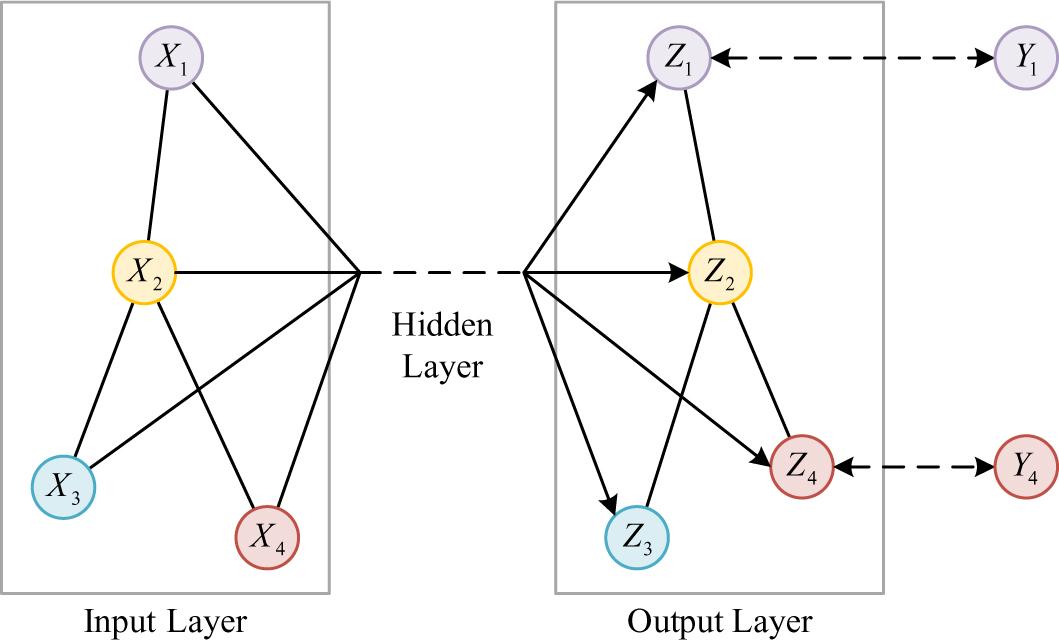
GCN model
The core of semantic matching based knowledge graph technology is to map entities, attributes and their interrelationships to a specific semantic space, calculate their similarity, and then optimize the embedding vectors of entities, attributes and their interrelationships, and finally represent and reason about the knowledge graph effectively [30].
The matrix decomposition model is an important low-order embedding vector technique, that is widely used in recommender systems, and one of its most classic models is RESCAL. RESCAL model uses tensor decomposition to construct a knowledge graph; the triad (h,r,t) in the knowledge graph constitutes a tensor D, and the triad exists if Dhrt=1, and it does not exist if Dhrt=0. The RESCAL model aims to decompose the tensor D into relational embeddings and entity embeddings and finally let Dhrt ≈ hMrt. When given a ternary (h, r, t), his scoring functional equation is as follows:
The ternary group diagram of the knowledge map area of the EE course is shown in 2.
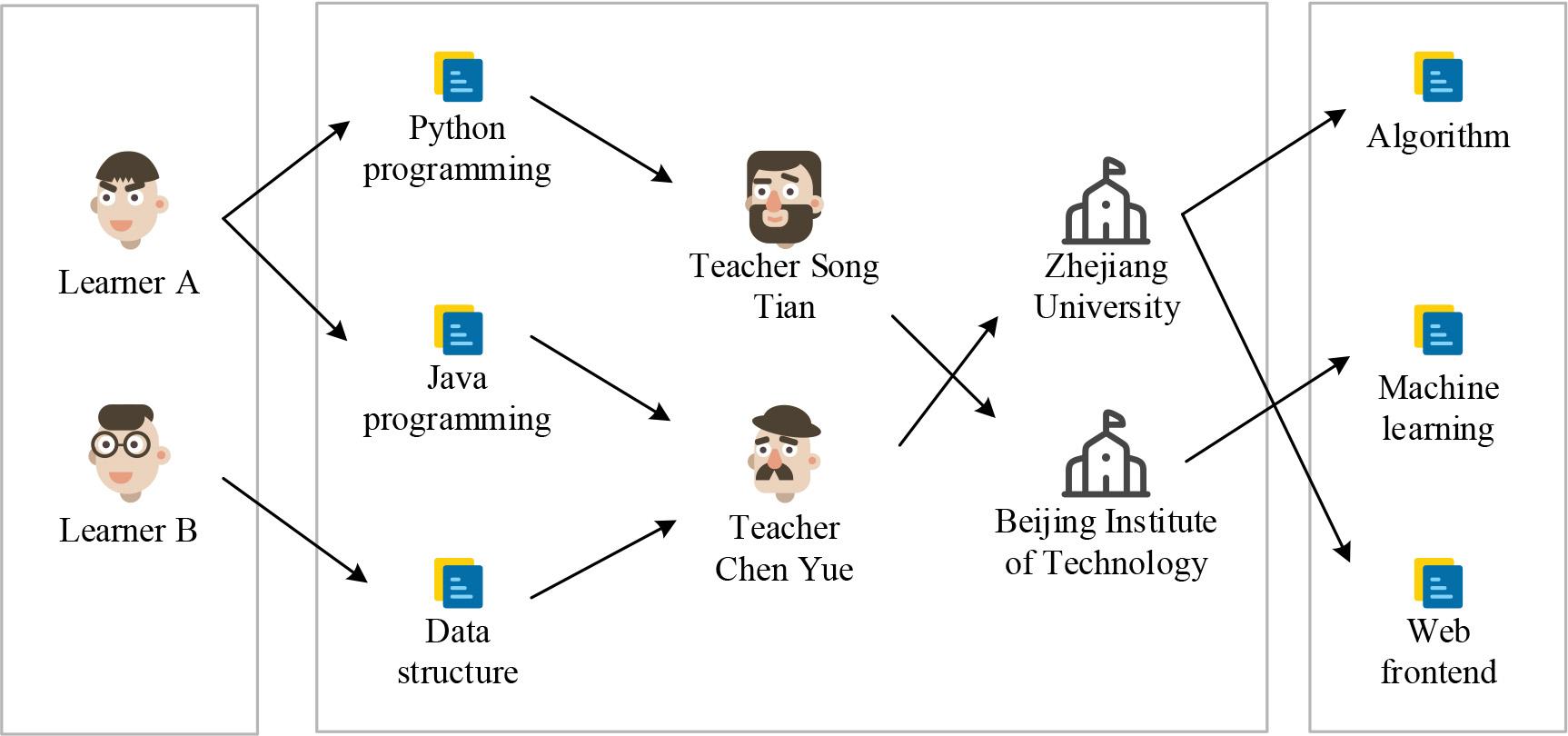
Triplet of curriculum knowledge graph
The core idea of the graph convolutional network recommendation model (KGCN) is to combine the rich semantic information in the knowledge graph with the convolutional operations in the GCN to generate more accurate recommendation results [31]. In KGCN, a knowledge graph is used to represent association and attribute information between users and items. In a knowledge graph, entities can represent users, items, and their attributes, while relationships describe the connection methods and semantic information between these entities. By representing entities and relations with embedding vectors in a low-dimensional space, KGCN can capture potential associations and semantic similarities between entities. The framework diagram of KGCN is shown in Fig. 3:
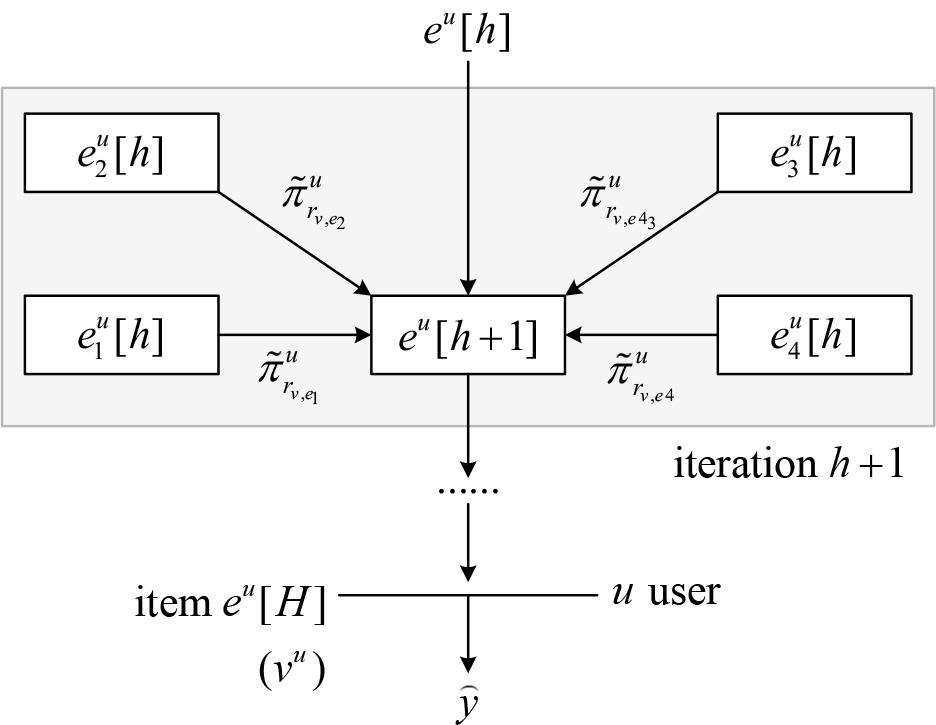
KGCN frame diagram
The main step of KGCN is to aggregate the information of neighboring nodes by constant iteration and then update the current node. But there is another important step before aggregation, that is, the similarity between the relational embedding and the learnable embedding must be calculated first, and the calculation formula is shown in equation (9):
In the above equation,
After obtaining the similarity between the relational embedding and the learnable embedding, the neighborhood of the node can be obtained by weighted summation of the neighboring entities
After aggregating the neighbors of a node with that node, the representation learning of that node can be updated.KGCN updates the node after performing the neighbor aggregation as shown in equation (12):
In the above equation,
Experimental environment: CPU: Intel(R) Core(TM) i5-9600K CPU @ 3.70 GHz 3.70 GHz
Memory: 16G
Hard disk: 1T
Operating system: Windows 10
Experimental software: PyCharm, Jupyter Notebook
Programming language: Python 3.7, Tensorflow 1.8, Pytorch 1.6
Data set: MOOCCube
In this section, the MOOCCube dataset is divided into a training set as well as a validation set in the ratio of 7:3, and the model is input for training as well as validation.
During the training process, the model adjusts the weights by comparing the loss of the model recognition output with the true value, and after 100 rounds of training, the Loss and Precision results of the model training and testing are shown in Fig. 4.
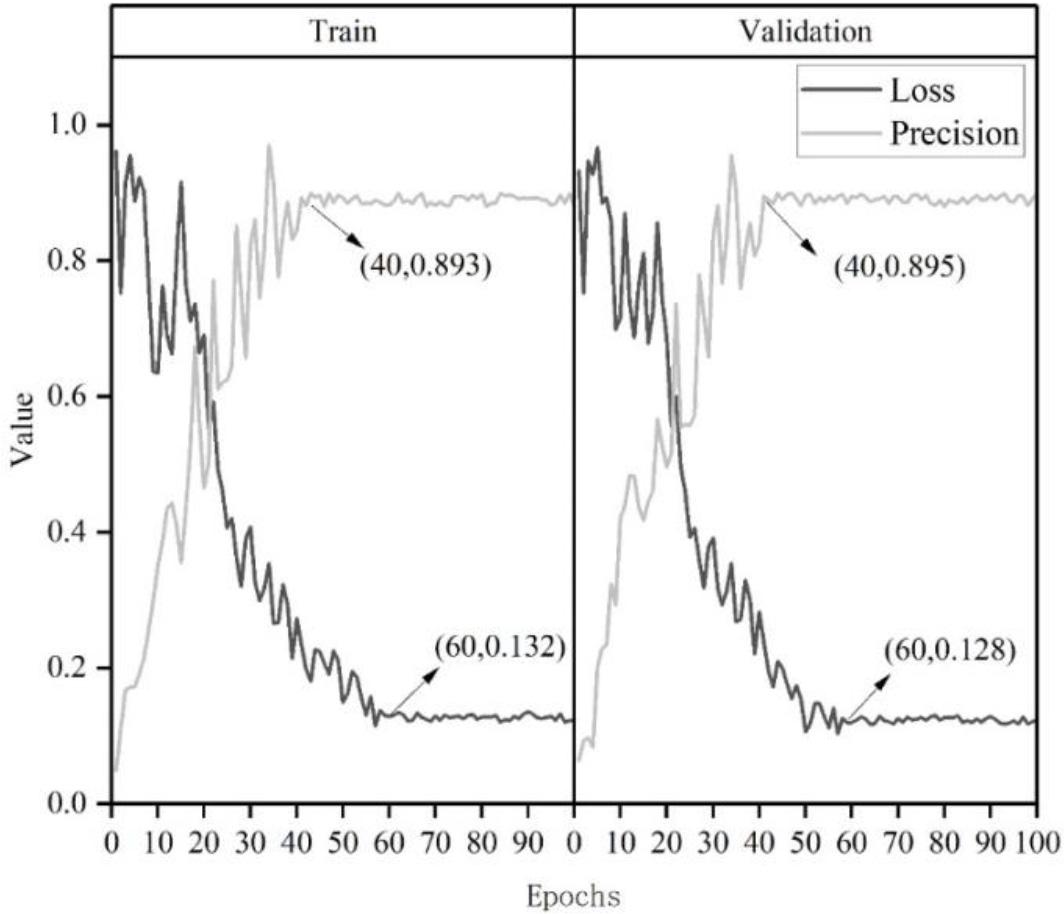
Model training and testing of loss-precision results
The data in the figure shows the difference in loss between predicted and true during training.Obviously, the loss gradually decreases until it is smooth, so it can initially be considered that the model achieves the fitting effect.
After each round of model training, the weight parameters of the current training are loaded and tested against the prepared validation data, thus verifying the model’s effectiveness.As can be seen from the figure, the model’s testing effect on the validation data is basically the same as that on the training data, and the model converges to about 0.89 after 40 rounds of iterations of both Precision and the subsequent training to about 60 rounds of training, the Loss decreases to about 0.13, which tends to stabilize.
In this paper, further ablation experiments are done to verify that graph convolutional neural network and knowledge graph can improve the model performance, comparing the graph neural network, graph convolutional neural network, graph neural network + knowledge graph, and graph convolutional neural network + knowledge graph in this paper, which are denoted as models 1-4 in order, and the test performance of the four models in the above dataset. The MOOCCube dataset is used in Figure 5 to display the results of the ablation experiments. As can be seen from the figure, the test results of this paper’s model on Precision, Recall, and F1 are 0.922, 0.947, and 0.893, respectively, which are higher than the comparison models.
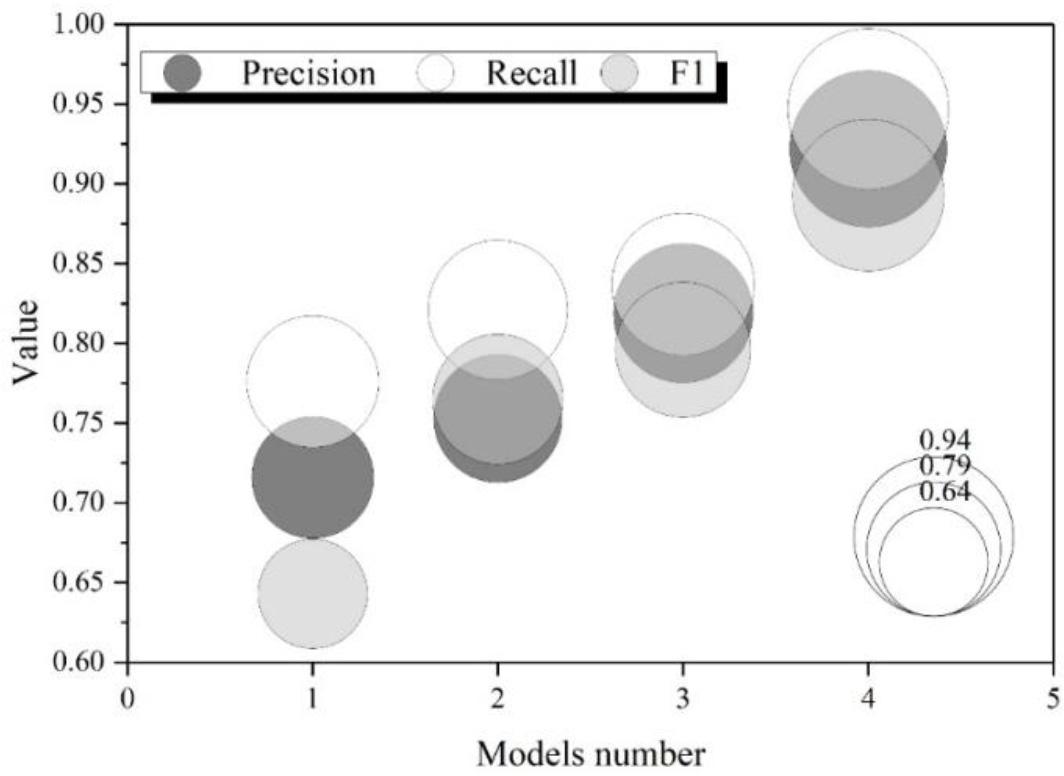
Experimental results of ablation based on MOOCCube data set
In this section, the built learning platform is validated for recommendation effect, and the MOOCCube dataset is also selected for validation experiments. Five models, FM, NFM, ECFKG, RippleNet, and KG-CR, are selected as comparisons. Figure 6 shows the results of the recommendation effect comparison experiment.

The recommended results compare the results of the experiment
As can be seen from the figure, the lower the number of recommendations the better the performance of the recommendation. When the number of recommendations is 10, the model of this paper recommends an accuracy of 0.942, which is significantly higher than the other groups of models. When the number of recommendations rises to 40, the recommendation performance of each model decreases, while this paper’s model improves 21.3%~29.7%, 6.6%~12.4%, and 10.4%~32.8% in Precision, Recall, and F1, respectively, compared with the comparison model.
The reasons for the improved performance of this paper’s model in online EE course recommendations are further analyzed. First, compared to non-knowledge graph methods, the algorithm proposed in this paper utilizes graph convolutional neural networks to model the higher order connectivity in the graph structure, which can capture more information between learners and courses. And using semantic knowledge graphs as auxiliary information can enrich the course representation and reduce the sparsity of data.
In order to explore the influence of the hyperparameter learning rate, entity embedding dimension and aggregation method in the experiment on the above experimental results, this paper changes the learning rate, embedding dimension and aggregation method for the experiment. The results of the influence of different parameters on the recommendation effect of electronic information courses are shown in Table 1.
| Project | Size or way | Precision | Recall | F1 |
|---|---|---|---|---|
| Learning rate | 0.0001 | 0.35 | 0.26 | 0.33 |
| 0.0005 | 0.41 | 0.31 | 0.37 | |
| 0.001 | 0.47 | 0.39 | 0.42 | |
| 0.005 | 0.54 | 0.46 | 0.49 | |
| 0.01 | 0.37 | 0.33 | 0.41 | |
| Entity embedded dimensions | 32 | 0.31 | 0.28 | 0.34 |
| 64 | 0.46 | 0.41 | 0.47 | |
| 128 | 0.34 | 0.36 | 0.33 | |
| Polymerization mode | Concatenate | 0.59 | 0.49 | 0.46 |
| Sum | 0.53 | 0.37 | 0.33 | |
| Bi-interaction | 0.63 | 0.55 | 0.57 |
From the table, it can be seen that for the influence of different parameters, with the increase of parameter values, the recommendation effect appears to increase and then reduce the trend. If the learning rate is too low, the experiment’s effect will not be good because too low a learning rate leads to the model convergence speed being too slow and may not achieve the optimal value. As the learning rate increases, the model becomes more and more effective. The best experimental results are obtained when the learning rate takes the value of 0.005. Precision, Recall, and F1 are 0.54, 0.46, and 0.49, respectively. The aggregation method is the best Bi-interaction, which makes full use of the way of summation and the way of the product of the elements, and the two ways complement each other.The aggregation approach is best with Bi-interaction, which makes full use of the summation approach as well as the elemental product approach, and the two approaches complement each other, thus performing the best.
The platform realizes the convenience of the user interface, the efficient processing of business logic, and the security and reliability of data access through B/S architecture. Specifically, the B/S architecture divides the platform into three levels, each of which undertakes specific functions and tasks. The online learning path recommendation platform’s overall architecture is depicted in Figure 7.
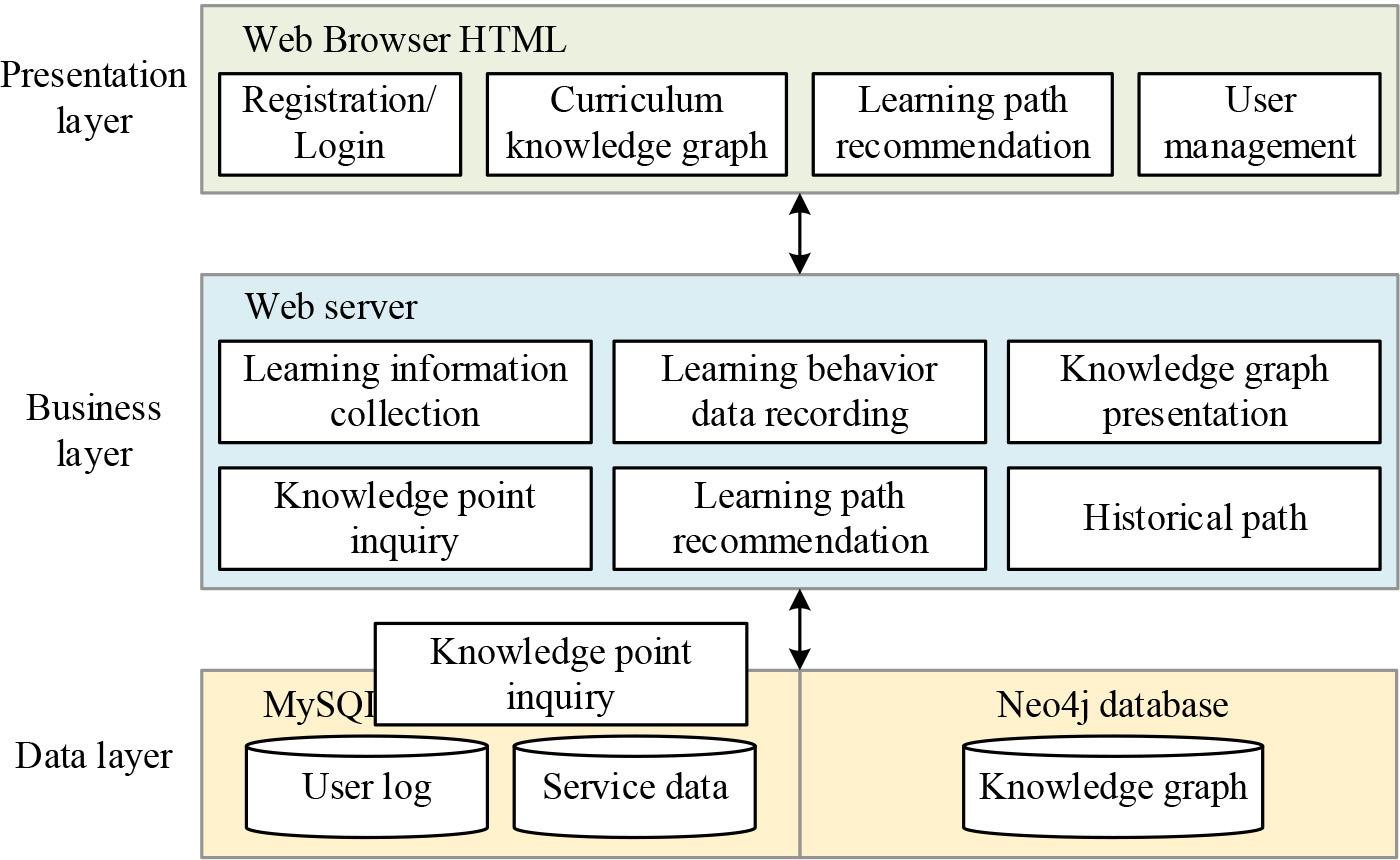
Overall architecture of the learning path recommendation platform
The representation layer mainly handles the interaction between the platform and the user. It is responsible for receiving request information sent by the user and displaying the corresponding response results in a web form. Learners can view the visual display of the course knowledge graph and obtain personalized learning path recommendations.
The business layer primarily handles business and process processing on data and transmits it to the data layer for storage, which is situated in the middle of the representation layer and data access layer. This layer mainly includes learner information management, course knowledge graph management, and learning path recommendation.
The data access layer is capable of adding, modifying, deleting, and searching for data in the database to ensure data integrity and accuracy. At the same time, the data in the database is effectively transferred to the business layer for business logic processing. The data processed by the business layer is safely stored in the database to ensure persistent storage of data.
The specific functions of the online learning platform are shown in Figure 8. This section further provides specific design and implementation details for each functional module to fully meet the diverse needs of users. The core modules of the learning path recommendation platform mainly include the learner module, the course knowledge mapping module, the learning path recommendation module and the platform management module, which together constitute the main framework of the platform.
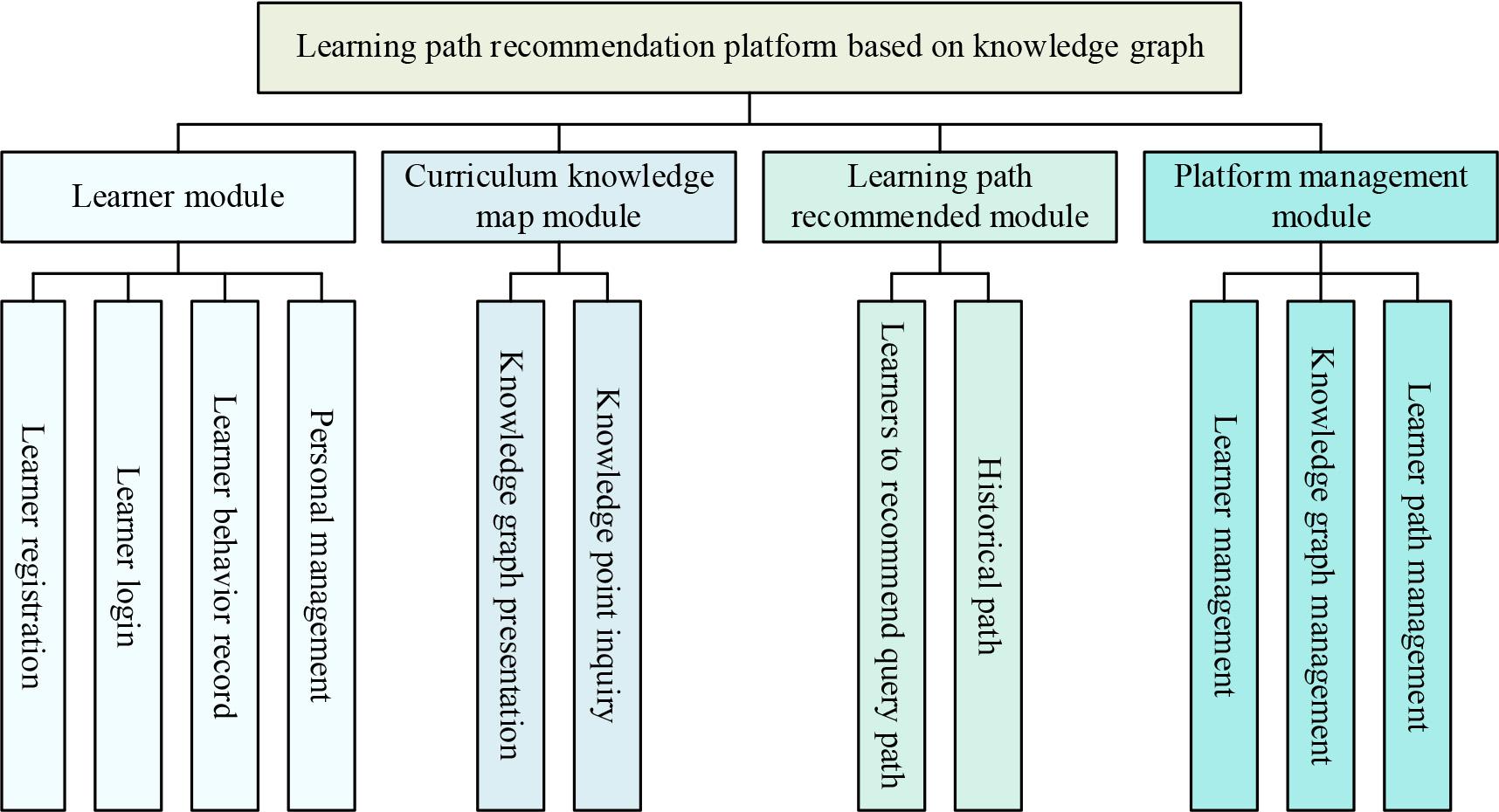
Platform function module diagram
When learners use the platform for the first time, they need to fill in their personal information according to the platform’s prompts and gain access to the platform by logging in. During the learning process, the platform module collects and analyzes these learning behavior records, and the platform is able to more accurately understand the learner’s learning needs and habits so as to provide more personalized and accurate learning path recommendation services.
The course knowledge map display shows the global view of the knowledge points of the electronic information engineering course; the knowledge point query refers to the fact that learners can query any knowledge point within the course to obtain the local view of the query knowledge point on the knowledge map. Learners can intuitively understand the connection between knowledge points and help learners better grasp the knowledge points related to the query.
The learning path recommendation query analyzes learners’ preferences for learning path recommendation through the course knowledge graph and learners’ learning behavior records, uses the PageRank algorithm to calculate the importance of knowledge points in the course knowledge graph at cold start, and recommends them to learners in descending order.
Learner management refers to the management of learners’ basic information and knowledge point learning, etc.; knowledge map management is to realize the addition, modification and deletion of knowledge points and the correlation relationship between knowledge points within the knowledge map; and learning path management can view students’ learning path.
The design process of the modular teaching mode of electronic information engineering courses mainly includes the following aspects: the first step is teaching analysis, including teaching content analysis, learner analysis, and teaching environment analysis; the second step is the design of course teaching objectives. The third step is to design the course module. The fourth step is the implementation of course modules. The fifth step is to design the module for teaching evaluation.
Analyzing this instructional design process shows that:
Teaching analysis is the foundation of the whole modular teaching design, which provides the basis for the subsequent modular teaching design according to the analysis of teaching content, analysis of learners, and analysis of the teaching environment. In the teaching of each module to sub-module and sub-module of the case task arrangement order for orderly teaching, in the teaching process of each sub-task using the case task-driven teaching method, to cultivate students’ hands-on practical ability. in the process of modularized teaching, respectively, for each course module develops appropriate assessment and evaluation standards, each module designates a special lecturer, one assessment and evaluation, and finally, comprehensive practical assessment results as the final results of the course, change the previous assessment of a test to determine the results of the assessment method.
In electronic information engineering courses, the implementation of modular teaching is the first thing to make corresponding adjustments to the teaching content, so the focus of modular teaching is to break the structure of the original course and the arrangement of the textbook, hands-on ability and the necessary computer literacy as the goal, the establishment of the course module.
The key to designing the course module is to determine the teaching content of each module. The determination of the content of each module should be based on the teaching objectives of the course to be achieved through the refinement and strengthening of the teaching objectives to determine the course needs to be mastered by the students of the basic capabilities, and then around the objectives of each module to determine the content of the teaching, the number of hours of teaching, teaching recommendations and implementation conditions.
The specific arrangement of the content of each module should be based on a real task. Multiple real tasks can constitute a large practical training project, the cognitive process involved in the project, the quality of the foundation, the cultivation of the ability to a thematic arrangement of the way integrated into a module through the development of the project training, to improve the hands-on ability of the students and the ability to innovate. Table 2 exhibits the modularized teaching content of electronic information engineering courses.
| Module | Module content | Time | |
|---|---|---|---|
| Module 1 | Overview of information technology | 4 | |
| Module 2 | Signal and data | Time domain and frequency domain | 10 |
| Analog and number words | |||
| Coding and modulation | |||
| Field and wave | |||
| Module 3 | Electronic devices and circuits | Circuit simulation and basic law | 6 |
| Transistor | |||
| Integrated circuit and operational advanced | |||
| Module 4 | Logic and digital system | Digital logic circuit | 8 |
| Sequence logic and priority machine | |||
| Computer and microprocessor | |||
| Embedded system and eda technology | |||
| Module 5 | Interconnection and computation | Communication and networkperception and calculation | 4 |
| Communication and networkperception and calculation | |||
| Module 6 | Professional and course guidance | 2 | |
| Module 7 | Course summary | 2 | |
Modularized teaching of electronic information engineering courses is implemented using the digital learning platform designed above. In this paper, the learning flat belt is equipped with a course knowledge map and a graph convolutional network recommendation algorithm, which can realize the recommendation of the student’s learning path at the same time, greatly mobilize the students’ enthusiasm for learning, and improve the students’ interest in learning. It has a positive effect on the cultivation of students’ analytical and problem-solving abilities, and is of great help in improving the hands-on abilities of students majoring in electronic information engineering.
In addition, the teaching mode also integrates “case task-driven” through the classic case study to put forward the teaching task, students in the teacher’s guidance, the teaching task to analyze, discuss, independent exploration and collaborative learning, and finally complete the teaching task.In the implementation of each module, the content of the course module consists of several teaching cases and teaching tasks, which requires teachers to ensure that the cases and tasks are feasible, easy to operate and interesting when choosing cases and designing tasks so as to integrate the knowledge and skills that should be grasped by students into the cases and tasks.
Implementation of modularized teaching in engineering courses. Two classes with the same level are selected for the teaching effect comparison experiment. The experimental class (T) adopts the modularized teaching mode of electronic information engineering based on the online learning platform of this paper, and the control class uses the conventional teaching mode, with 30 students in each class. The two classes were tested for their level of electronic information engineering knowledge before and after the experiment.
Table 3 shows the statistical results of the test level of the two classes before and after the experiment, Figure 9 shows the test results of the electronic information engineering knowledge level of the two classes before the experiment, and Figure 10 shows the test results of the electronic information engineering knowledge level of the experimental class after the experiment.
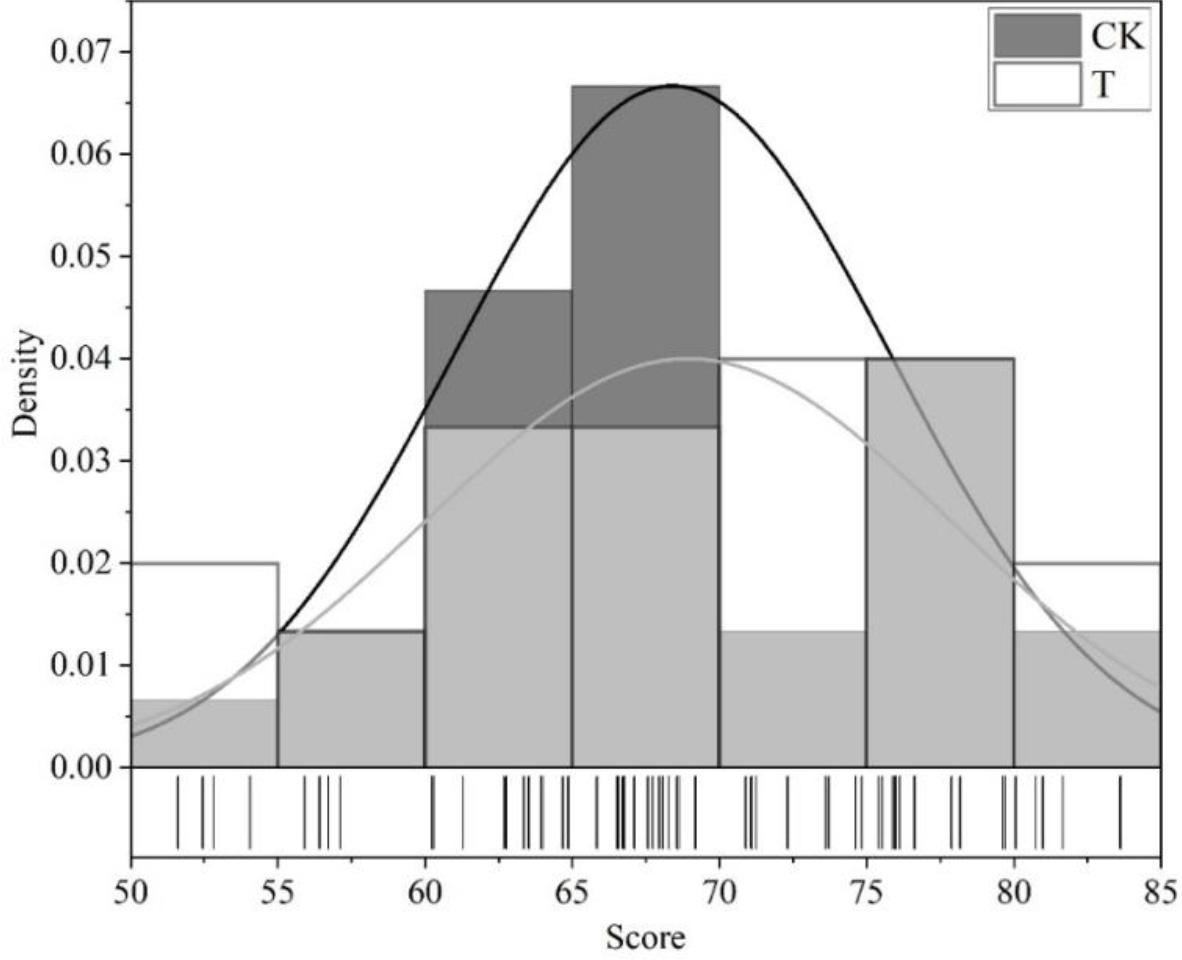
Test results of the first two classes of knowledge
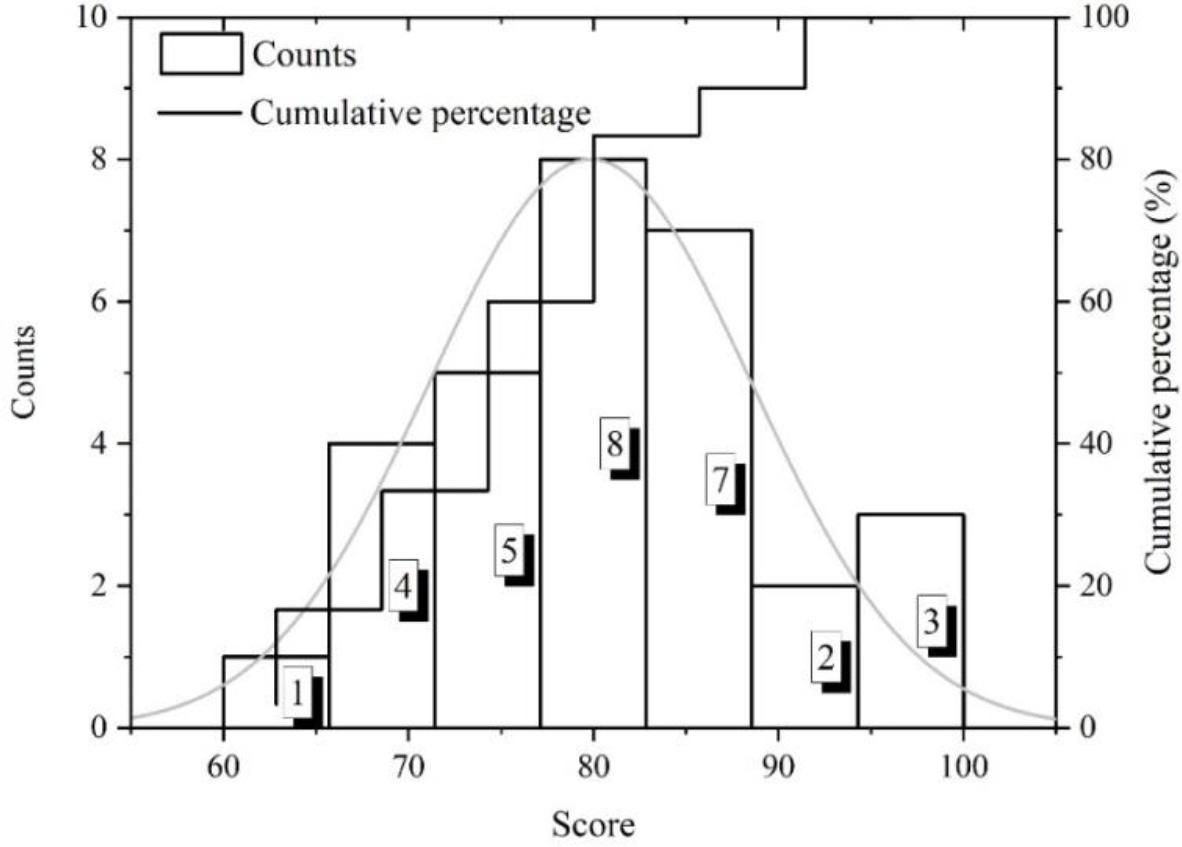
Test results of T class knowledge level after experiment
Combined with the charts, it can be seen that before the experiment, the average scores of the two classes of CK and T were 68.40 and 68.94, respectively, and the P-value was 0.542, which was greater than 0.05, i.e., there was no difference in the level of knowledge of electronic information engineering between the two classes before the experiment.After a semester of teaching experiment, we can see that after the implementation of online learning modular teaching, the performance of students in the experimental class has improved significantly, the number of excellent and good numbers have increased compared with the students in the control class, and the number of failing students has been greatly reduced. After the experiment, the p-value of the knowledge level between the two classes is 0.012 < 0.05, showing a significant difference between the two classes.
| Pre | Post | |
|---|---|---|
| CK class | 68.40 | 72.27 |
| T class | 68.94 | 79.83 |
| P value | 0.542 | 0.012 |
In this paper, 100 students were randomly selected at the end of the teaching practice to carry out a questionnaire on the learning situation of modular teaching applications of online learning platforms in electronic information engineering courses. The questionnaire content is designed to analyze 5 aspects, namely, students’ independent learning, teamwork, students’ knowledge and skills mastery, students’ learning gains, and students’ practical ability, and 2 questions are set for each level. Each question option is set with 5 levels, i.e., very satisfied, satisfied, average, dissatisfied, and very dissatisfied, in order of rating 5-1. The results of the student’s evaluation of the modularized teaching effect of the e-Informatics Engineering Online Learning Platform are shown in Figure 11.
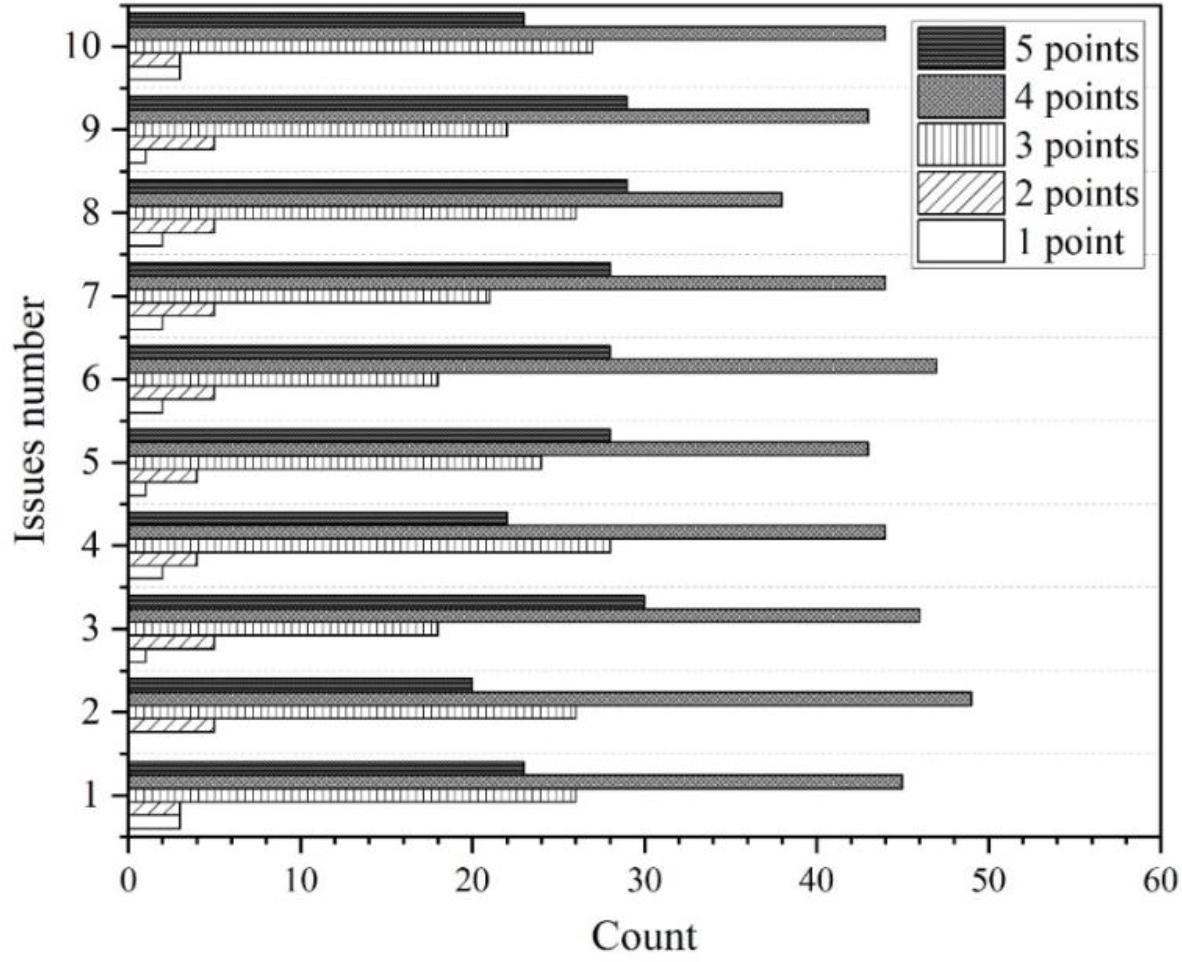
Students’ evaluation of the teaching effect of the online learning platform
As can be seen from the figure, the highest percentage of students’ evaluation of the five dimensions was “satisfied”, which accounted for 41% to 47%. The average ratings of independent learning, teamwork, students’ knowledge and skills mastery, students’ learning gain, and students’ practical ability were 3.83, 3.895, 3.935, 3.89, and 3.875, and in terms of independent learning, most of the students indicated that the modularized teaching of the online information platform enhanced their interest in the EE course and that the use of the platform could help them complete the tasks of each class independently, indicating that the students’ awareness of independent learning had been improved. It can help students complete the tasks of each class independently, indicating that their sense of independent learning has improved.
This paper constructs a knowledge graph convolutional network recommendation algorithm based on electronic information engineering in order to build an online learning platform, aiming to optimize the structure of the electronic information engineering course through the accurate recommendation of the learning path. On this basis, a modularized teaching design is carried out for the electronic information engineering course, and it is applied to colleges and universities to evaluate the teaching effect.
The recommendation model in this paper shows better recommendation performance on training data and validation data. In the ablation experiment, the Precision, Recall, and F1 of this paper’s model are 0.922, 0.947, and 0.893, respectively, which are much higher than the base model.
The model in this paper improves 21.3%~29.7%, 6.6%~12.4%, and 10.4%~32.8% on Precision, Recall, and F1, respectively, compared to the comparison model when the number of recommendations is 40. The best experimental results Precision, Recall, and F1 of 0.54, 0.46, and 0.49 were obtained when the learning rate took the value of 0.005.
There is no significant difference in the level of EE knowledge between the two classes before the experiment, while after the experiment, the evaluation scores of the experimental class and the control class are 79.83 and 72.27, respectively, showing significant differences.
Learning satisfaction with the evaluation of the teaching mode of this paper is high, and the average scores of the teaching evaluation indexes are all higher than 3.8.
